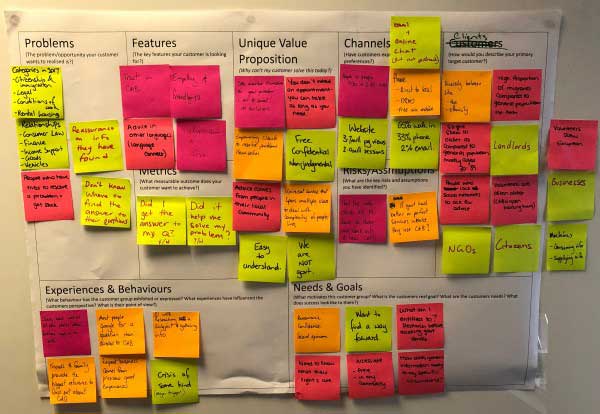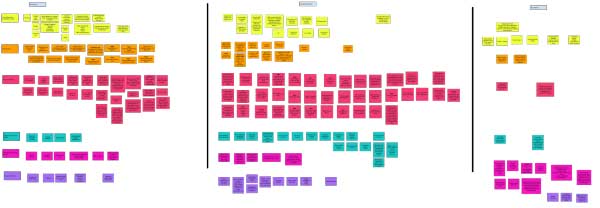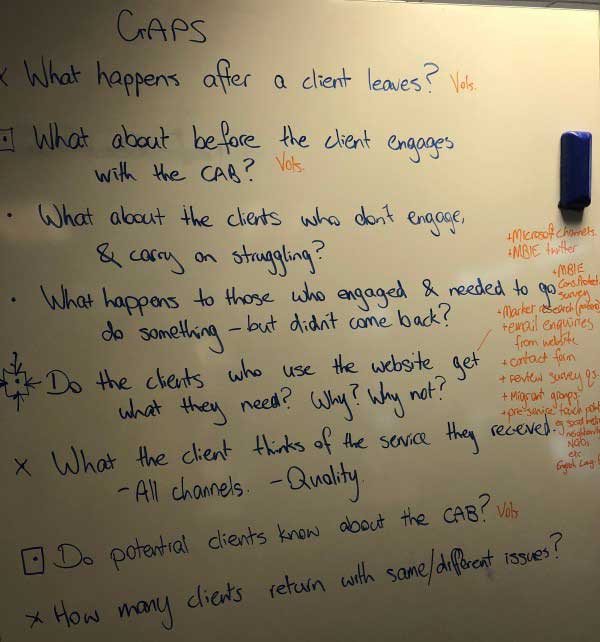Guest blog post from Mike Curry, National Development Advisor, Citizen Advice Bureau New Zealand in collaboration with Pia Andrews from the Service Innovation Lab, Department of Internal Affairs (DIA).
TL;DR
In December 2017 the Citizens Advice Bureau New Zealand (CAB) spent some time in the Service Innovation Lab to think through some upcoming technology challenges. Specifically we needed to better understand our online audience and their needs. To do that, we needed more tools in our kete. However, we also had limited experience working in an agile way, so were intrigued to find out whether a week-long discovery sprint with the team at the Service Innovation Lab could provide us with something tangible, something useful, and something that will help us engage effectively with a technology partner in 2018. The full report from the sprint is available and below are some insights and what we got from the process.
The challenge for CAB
The Citizens Advice Bureau is a universal signpost service: open to anyone to ask any question. Our volunteers fielded 525,000 client interactions last year through our walk-in and phone services.
While working with clients in person, we have the opportunity to find out details that help form a wider understanding of social issues, and ways in which we can help. Our website houses much of the information that supports our service delivery. However, we did not know whether the people coming to our website were being served by this same information, or if their needs were different. The nature of our service meant there were few opportunities to access our web clients directly.
We assumed our web clients were the same as our in-person clients, and wanted to challenge this assumption.
Key question: Is our online client base the same as our in-person client base?
Analytics only told us so much – and with a website redevelopment coming in 2018, we needed to answer this question, using existing resources.
The challenge for Service Innovation Lab
The Lab often works closely with different agencies and service providers to explore the possibilities of digital service delivery, or more digitally enabled services. We have identified throughout the various life events that people don’t always come to government in the first instance, for a variety of reasons. As such, we wanted to test the general assumption that digital transformation of government services was in fact sufficient to serving the community. CAB have a large number of clients and we assumed it was because of a lack of fit for purpose services to those user needs.
Key question: Would CAB clients want to come to government in the first instance if there were perfect government services?
The collaborative process
We began with a customer canvas (see below) using our existing knowledge to describe our current client base and assumptions.

This progressed into a first cut of a current state user journey map (see below, or explore in detail here), which helped us articulate details of our client user experience, but also helped smash a myth among some that CAB only helped with legal questions (in fact, we help with any question).

Perhaps the most important learning from this exercise was the part of the user journey we could not see clearly, which is why we then created a list of gaps in our knowledge and began exploring ways to fill them.
We also looked at the website analytics to identify any patterns of usage, needs or behaviour that could assist us. The insights are in the sprint report and provide some useful pointers to further explore. It was also interesting to compare what we knew about our walk-in or telephone clients against what we could see in the website behaviours.

In understanding the user needs and why they came to CAB in the first instance we compared anecdotal evidence against case management statistics for walk or phone-in clients, and against web analytics for website behaviour. We also interviewed CAB volunteers as a proxy to understanding genuine client needs and why they came to CAB. Throughout the process our collective team intentionally did not engage with clients directly or client information to ensure we maintained the privacy and confidentiality of the service.
We found that clients went to CAB because of three key reasons with three different implications:
- Clients get integrated services from CAB where they pull together information and services across government departments and other sectors to help people navigate the complexity and get what they need.
Digital Government inference: integrated services that draw together information and services around user need and across agency and sector boundaries would help CAB clients and would also provide a good service for CAB volunteers to help clients. - CAB provide specialised services to help people to engage with government such as legal services, interpretation services and in some cases, a food bank service.
Digital Government inference: digital or digitally enabled government services may simplify specialist services but many CAB clients would likely continue to need these specialised services. - There were three particularly large groupings of CAB clients that simply would not engage with the government in the first instance for a variety of reasons including fear and confusion. These three groups were broadly, and in no particular order, seniors and retirees, people with English as a second language, and people with complex conditions making them particularly vulnerable.
Digital Government inference: digital or digitally enabled services will not serve these clients except indirectly through enabling third party providers such as CAB. Given there are over 500,000 clients of CAB each year, this has significant implications.
The result
At the end of the week we had:
- a completed customer canvas which provides an at-a-glance understanding of our client base
- a draft user journey map which will be expanded into personas and a mood chart
- a list of ways to fill the gaps in our knowledge of our online audience
- practical experience using an agile methodology.
From CAB’s perspective, we still hadn't answered the original question. Rather than provide us with the answer directly, the time we spent at the Service Innovation Lab empowered CAB with the focus, tools and methods to answer our questions on an ongoing basis.
For the Service Innovation Lab, we found a reasonably high confidence null hypothesis in that many CAB clients wouldn’t engage directly with government even with digital transformation of government services because of clients' highly complex needs, including clients in vulnerable situations, English as a second language and seniors. This is an important finding to now explore further.
The CAB team are very grateful for the time we had with the Service Innovation Lab and believe we have been set up to succeed with our upcoming technology challenges.


